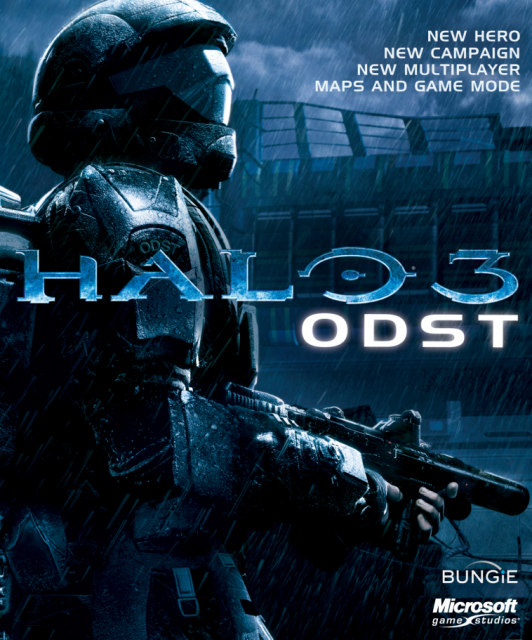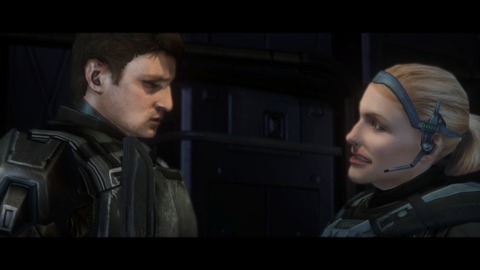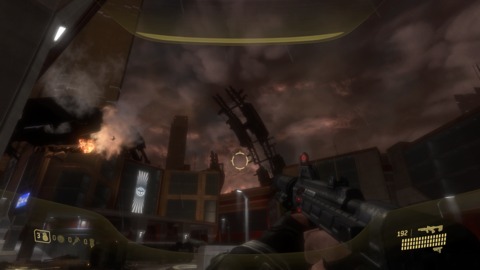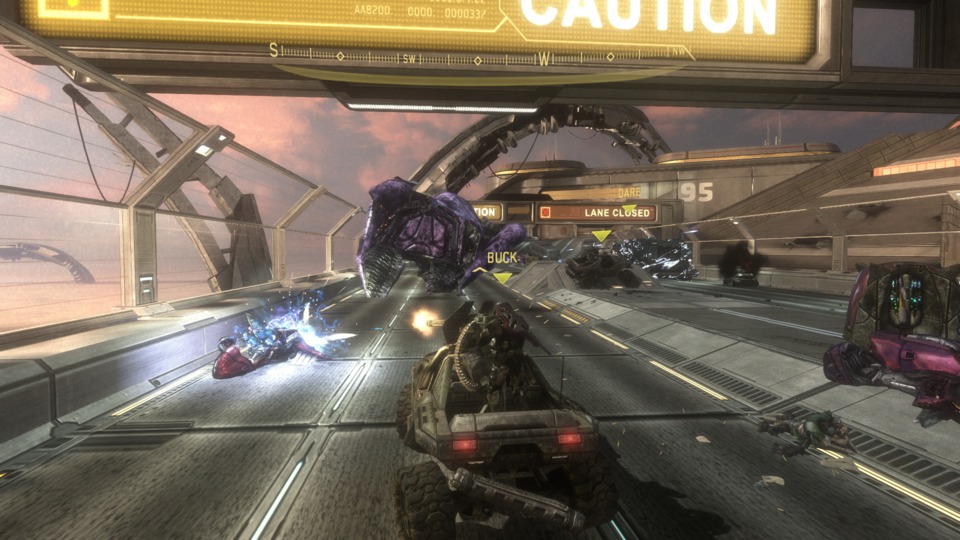The Great Journey Keeps It Clean - Halo 3: ODST
By Darth_Navster 5 Comments
This is the latest in a series of retrospective write-ups where I relate my experience playing through the campaigns of the Halo series all over again, this time in the remastered form of the Master Chief Collection. You can find previous posts in The Great Journey here:

Hello dear readers, let’s turn the lights down and groove out in war-torn New Mombasa. Today’s edition of The Great Journey is focused on one of the more peculiar entries in the series, Halo 3: ODST. The game was released as a standalone boxed title, but it feels more like an expansion pack to Halo 3 in its design. So while ODST lacks the technological “wow” factor when compared to previous titles, it implements some intriguing tweaks to the Halo formula that makes it stand out compared to its predecessors. There’s a somber, almost film noir mood to the game that informs quite a bit of the gameplay and introduces a nuance to Halo that feels fresh. It’s intriguing right off the bat, but does the game coalesce into anything more than an also-ran Halo 3 campaign?
The ODST in the game’s title refers to Orbital Drop Shock Troopers, a sort of elite space paratrooper unit that stand only behind the Spartans in the UNSC’s unofficial badass ranking. So while you are still playing as an elite soldier, you’ve taken a step down since the last game. Being not quite a Spartan comes with some gameplay tweaks, from large changes like reduced durability and the reintroduction of health kits, to minor ones like silenced weapons and no dual wielding. It admittedly doesn’t add up to a fundamental gameplay shift from Halo 3, but the whole package becomes worthwhile thanks to the unconventional (for shooters) story and fantastic mood setting.
The game’s story takes place during the events of Halo 2 after the Master Chief leaves Earth. It opens with your ODST squad bantering inside of a spaceship while readying for a drop onto a Covenant ship hovering above Halo 2’s megacity, New Mombasa. The squad consists of Buck, Dutch, Mickey, Romeo, and the Rookie. The troopers are joined on the mission by Office of Naval Intelligence (ONI) spy, Dare. ODST immediately goes for geek approval by filling out its voice acting cast with actors from much loved sci-fi shows as Firefly and Battlestar Galactica, and the voice work acquits itself just fine. The dialog feels a bit more nuanced than in Halo 3’s grandiose script and is backed up by a wonderfully jazzy score. In my previous entries I’ve neglected to comment on the music as I felt that the iconic nature of Martin O’Donnell’s work didn’t need to be discussed yet again. But for ODST, the soundtrack deserves special praise for feeling like Halo while still setting a different mood than that of the Chief’s adventures.The one part of the presentation that falters, however, are the visuals. It’s clear that Halo 3’s graphics engine is being stretched by ODST’s demands on it, and character faces are probably the biggest indicator of this. Granted, faces did not look or animate all that great in Halo 3, but due to the fact that most of the important dialog was said by a faceless protagonist and his incorporeal sidekick, it didn’t feel like a major detriment. Unfortunately ODST has long and drawn out scenes with characters trying and failing to emote in a way that isn’t completely off-putting. The situation is worsened by the fact that certain characters, like Nathan Fillion’s Buck or Tricia Helfer’s Dare, were designed to look like their voice actors. Instead they look like ugly mannequins when compared to their real life counterparts. The game mitigates this slightly by having most in-gameplay dialog delivered by helmeted characters with their faces covered, but the emotional high points of the story are still delivered via cut scenes. But even with this, the game still manages to impress thanks to a cleverly told story.

The game properly starts with you as the voiceless Rookie about to drop onto the Covenant ship stationed above New Mombasa. Not all goes according to plan, however, and the ship warps away, leaving you and your squad crashing down onto the city. A few hours pass and the Rookie finally comes to with no sign of what happened to his team. From here you’re left to wander around the streets of New Mombasa searching for any clues as to their whereabouts. Right off the bat the game establishes a different tone, with zero dialog and a tutorial delivered entirely in text on your display. At first you’re given no explicit direction, but context clues in the environment seem to guide you where to go. Various traffic signs and road blocks activate as you approach in a deliberate manner, almost as if you’re being observed and guided. It’s a delightfully eerie sensation that makes sure that you never really feel like the nigh-invincible Master Chief. Even enemy encounters feel heightened by your lesser durability and the standard loadout not being all that effective against the countless Brutes patrolling the area. I quickly realized that avoidance was the best strategy and kept to cover. Stealth is not really something that the Halo series has ever engaged with before, and truthfully ODST is not exactly built for it. But Bungie has wisely kept these sections to a minimum and gives the player plenty of opportunity to run away in case they are spotted. So while you don’t quite feel like Solid Snake, the hectic and sloppy stealth works fine here. It’s effective in emphasizing the desperate and isolated situation the Rookie is placed in and makes it all the more satisfying when you finally locate a clue as to what happened to your team.
The levels in ODST all stem from the Rookie locating a clue, such as a damaged helmet or used medical foam canister, and the game flashing back to some point between the failed drop until the point that the Rookie awakens. The missions themselves mix things up by putting you in the shoes of all of your team mates as they try to regroup and salvage what they can from their failed operation. The central mystery of the game is somewhat spoiled by the events of Halo 3, but the intrigue around the ONI agent Dare’s location and her ultimate objective are enough to drive the story forward. The game uses its episodic structure effectively by doling out just enough story beats to keep the player moving on to the next clue to unravel the mystery. But a detective’s tale this is not, and ODST lives up to its predecessors by offering plenty of enemies to shoot.

While the Rookie’s segments deviate from the Halo gameplay formula, the missions themselves hew closer to the core series. The engagements against the Covenant are more head on and feel very much like Halo 3 firefights. It’s strange that this is the first game in the series where there is no Flood present, and while I can’t say that I miss those infectious jerks, the enemy variety leaves much to be desired. You will only fight Brutes, Jackals, Grunts, Drones, and Engineers, which make their debut in ODST. Engineers are floating jellyfish-like aliens that mostly act as support units for the Covenant by buffing their shields and have a nasty habit of exploding when shot at. They admittedly add a new wrinkle to the gameplay (and have the cool distinction of appearing in the books first), but fighting just this subset of the Covenant can get tiring after a while. It’s not so bad as to stop the story’s momentum but it does feel like a bit of a step back. Luckily the mission variety itself is quite good, and it’s refreshing to return to a human urban environment after spending so much time in Halo 3’s more earthy levels. The missions take place in a variety of locations, including a nature preserve, ONI headquarters, and even the city’s rooftops high above the clouds. These missions, along with the Rookie’s interstitial segments, all mix up the scale of the world and how the player engages with it. There’s a great mission in the game’s back half that exemplifies this use of scale by having you pilot a Banshee to escort your team who are flying a Phantom, or a Covenant transport ship. The mission offers plenty of wide open spaces to engage in dogfights with enemies, but there are certain points where you must hoof it to open hangar doors for the ships to get through. While in the air you were afforded some covering fire by your team, on foot you are isolated and forced to engage with the enemy alone. This mission also uses ammo scarcity to really drive home the difference in being cut off from your team and proves to be a tense change of pace when compared to the freewheeling combat flying the Banshee. After several of these segments, the mission culminates in a massive battle against a Scarab that acts as the mission’s final boss. Having your team distract the walking tank while you attack it’s power core at the rear provides a near perfect implementation of the dynamics you slowly learned throughout the mission. While I will say ODST has the most consistent campaign of the series so far, this specific mission (known as Kikowani Station) is an absolute delight. It also leads into one of Halo’s strongest endings.
The final two missions have the Rookie and the rest of his squad finally figuring out where Dare had gone off to. As the Rookie, you descend into New Mombasa’s data hive core to find out the the mysterious ONI agent. The level is the first one of the game that I would consider to be “tight”. It’s very much one corridor after another, but the halls are littered with cover and an inclined plane to make the combat feel dynamic. The amount of enemies isn’t much and it’s relatively easy to take them down, so it feels more like a chaotic mad dash to get to the bottom of the data hive. The Rookie truly comes into his own as a Halo-worthy badass in this segment. The shotgun becomes for what feels like the first time an effective weapon against the Covenant, with plenty of ammo to one-shot hapless Grunts and Jackals. When you eventually reach the bottom you meet up with Buck and the game unveils its final twist. Dare was in search of New Mombasa’s Superintendent AI, which had intelligence on what the Covenant were looking for on Earth. It appears that the helpful street signs and beacons that were helping the Rookie all night was the Superintendent guiding the player in order to facilitate its extraction. But the Superintendent is no computer, as it has now merged with a Covenant Engineer. Once it’s agreed to extract the Engineer, the game tasks you with fighting out the way you came in. What I expected to be a slog akin to Halo 1’s repeated missions instead turns into a fun firefight with the Engineer’s shields working for me instead of for my enemies. The team quickly gets back to street level and finds a Warthog to kick off the last leg of the campaign.

The final mission involved an escape to get to extraction, which on the surface seems like a rehash of Halo 1 and 3’s endings. But the escape is more slower paced here, with Bungie cordoning off advancement until all enemies in a given segment are killed. It also helps that every few sections you’re given a better vehicle to upgrade to, first starting with a standard Warthog, then a Gauss Warthog, and finally a Scorpion tank. After slinking in the shadows all game this felt like a blast of empowerment and I enjoyed every minute of it. The very final part of the game is a sort of last stand while waiting for extraction on the steps of a building. The challenge here is stiff but never feels unfair as you’re given a veritable armory inside the building and the Engineer shielding you. After several waves of Covenant, the rest of the squad arrives in the stolen Phantom and make short work of the remaining enemies and extracting the Rookie, Dare, Buck and the Engineer to safety. The game wraps up with a short epilogue of Sergeant Johnson interrogating the Engineer, kicking off the events of Halo 3.
Halo 3: ODST as an experiment largely succeeds by accepting its limitations and working within them. The game doesn’t try to stake out a new Halo paradigm like the previous games, but it makes great strides in storytelling that future titles have tried to mimic. I highly doubt that we’ll ever see another ODST-like product in the Halo series and it’s a shame. Bungie clearly showed a willingness to experiment with their established formula and I hope 343 is given the chance to do the same before the current Halo trilogy is done. In any case, ODST as it currently stands is simply a fantastic entry into the Halo franchise and a must-play for Halo fans.